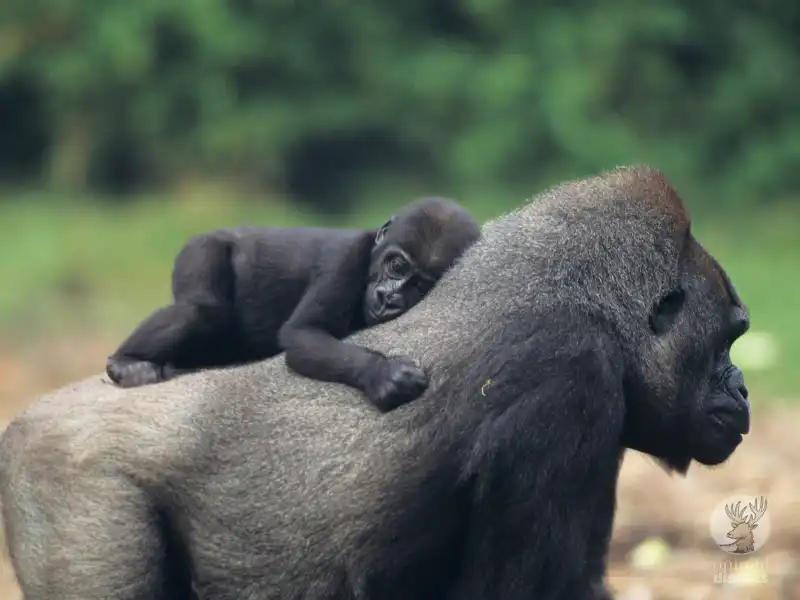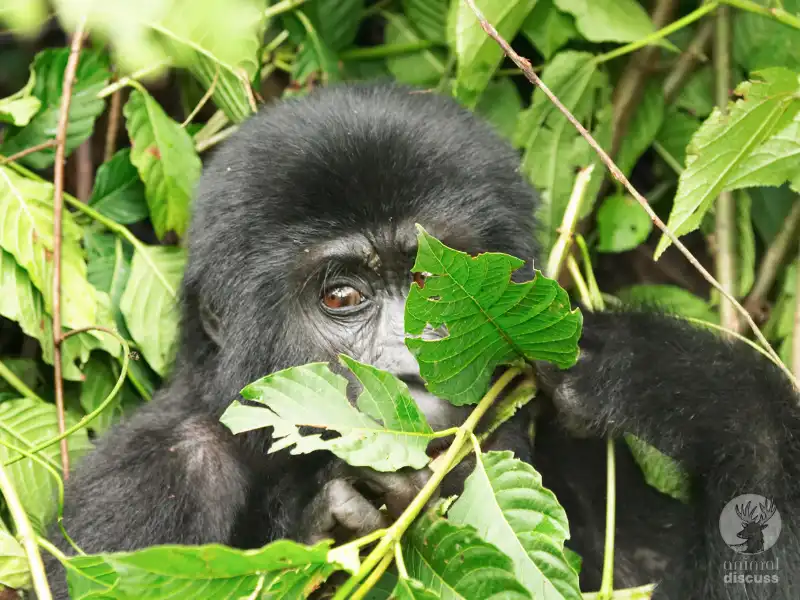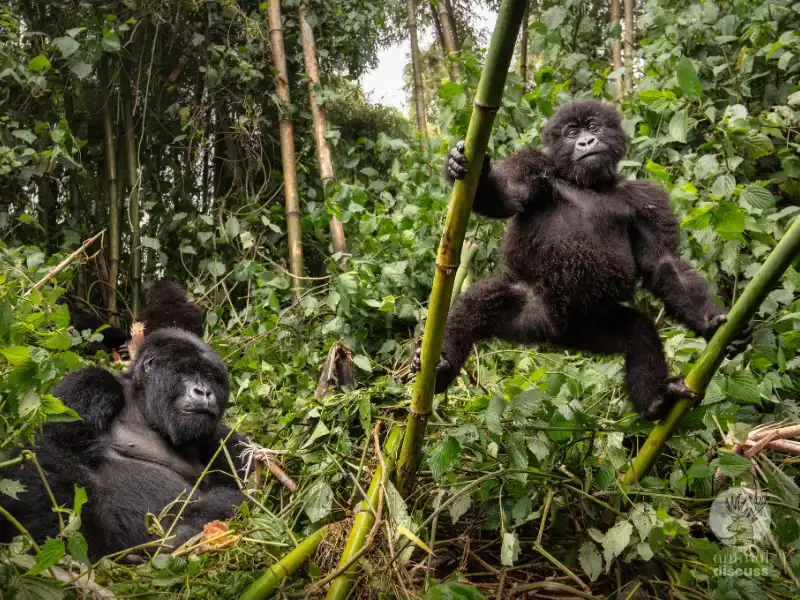Have you ever thought about where the Gorillas live? The giants of the African forests can be found in various habitats all over Africa. On the other hand, these animals face various factors threatening their survival like habitat loss, climate change, and poaching.
In this article, I have mentioned the habitat diversity of gorillas, key habitat components, and factors that influence their wildlife. I have also discussed the challenges they face in habitat and the conservation tactics that are necessary to protect them.
What Is the Habitat Diversity and Distribution of Gorillas?
The species of western and eastern gorillas live in distinct areas. Here is a brief outlook –
| Types | Habitat |
|---|---|
| Western Lowland Gorilla | Cameroon, Central African Republic, Gabon, Republic of Congo, and Equatorial Guinea |
| Cross River Gorilla | Nigeria and Cameron |
| Eastern Lowland Gorilla | Congo |
| Mountain Gorilla | Uganda, Rwanda, and Congo (Kinshasa) |
Western Lowland Gorilla
Western Lowland Gorillas inhabit the lowland rainforests of Central Africa. They are found in Cameroon, the Central African Republic, Gabon, the Republic of Congo, and Equatorial Guinea.

These Gorillas are the most widespread gorilla subspecies. They are known for their adaptability to various forest types. These Gorillas reside in dense vegetation and swampy habitats, often found near rivers and streams. [Reference 1]
Cross River Gorilla
On the other hand, Cross River Gorillas have a limited distribution along the forested region in Nigeria and Cameroon. They are one of the rarest and most endangered gorillas. Cross River gorillas inhabit rugged terrain with steep slopes and dense vegetation.
Eastern Lowland Gorilla
Eastern Lowland Gorillas are endemic to the eastern Democratic Republic of the Congo. They primarily inhabit the lowland rainforests, mountain forests, bamboo forests, and swampy areas of the region.
These gorillas are the largest of the gorilla subspecies. They have adapted to diverse habitats within their range.
Mountain Gorilla
Mountain gorillas are found in the highland terrain bordering Uganda, Rwanda, and Congo (Kinshasa). They inhabit montane rainforests and bamboo forests at elevations ranging from 2,200 to 4,300 meters above sea level.
These Gorillas have adapted to cooler temperatures and steep slopes.
Overall, gorillas play a vital role in maintaining the health and biodiversity of their forest ecosystems.
Read this article to know more about Gorilla in this article.
What Are the Key Habitat Components for Gorillas?
Ever wondered about the key elements of a Gorilla’s habitat? They depend on various habitat components for their survival. These include vegetation, sources of water, and stable temperatures. It guarantees an uninterrupted food supply and better well-being for them all year round.
Let’s learn more about those key components –
Vegetation
As I mentioned earlier, gorillas live in dense vegetation. The diets of these animals are made up of stems, shoots, leaves, and fruits. Native to their places, the different plant species serve as a great meal nutrient source and food option.

Besides, various tree clusters help them hide from enemies and adverse weather. Thus, it helps gorillas to search for food, rest, or to communicate with their companions.
Water
Other than vegetation, water is one of the most important factors for the gorillas. It is inevitable in their hydration and cleanliness. Their survival is dependent on natural water sources which include streams, rivers, and ponds.
These water resources are very essential to their physiology even though they rarely drink.
Environment
Likewise, the environment with stable temperature is another key component of Gorillas. They live in the dense forests of the tropical and subtropical regions.
These are characterized by persistent rainfall throughout the year and relatively constant temperature conditions.
Basically, the climate in this area facilitates the growth of plants and it allows the gorilla families to survive the whole season. And Central Africa is the best example of their physiological needs.
What Are the Habitat Challenges Gorillas Face?
Gorillas face several habitat challenges. First, the biggest threat is the loss of habitat from deforestation. Additionally, climate change destroys the places where they inhabit.

The transfer of diseases due to tourism is another mentionable challenge. On top of that, their numbers are reducing for illegal wildlife trade.
Let’s take a closer look in detail.
Habitat Loss
Do you know Gorillas lost most of their habitats because of deforestation? Human activities like logging, agriculture, and infrastructural development destroy their forest.
The conversion of forests into timber resources, farming, and urbanization in the Gorillas’ territories reduces their habitat.
Climate Change
This phenomenon is common and also intensifies habitat degradation and transforms ecological conditions in gorilla habitats. Extreme climatological incidents like droughts, floods, and fire outbreaks damage gorillas’ habitats. It creates food scarcity.
Disease Transmission
Another threat you should know is the transmission of disease. Gorillas might suffer from respiratory illnesses, digestive disorders, and zoonotic pathogens.
Ecotourism and research-based activities promote blind contact and higher chances of spreading these diseases. Hence, this reduces the health status of the gorillas and population viability.
Illegal Wildlife Trade
At last, exploitation has shifted the gorillas’ role from an endangered species to becoming cultural, medicinal, and exotic pets. But trafficking channels transport gorillas and gorilla body parts across the globe over national borders illegally.
These habitat challenges require collaborative efforts for conservation and restoration initiatives.
What Are the Conservation Strategies of Gorillas?
For the conservation of gorilla habitats, governments should monitor protected areas. Along with this, community engagement is very significant.
Moreover, actively implementing sustainable development programs and strengthening the law against criminal offenses is essential in tackling the threats. Likewise, there is more to do to save their habitats.
Let’s learn detailed information about the strategies –
Managing Protected areas
The first strategy is creating and ensuring the proper management of protected areas by the government. For example, national parks, wildlife reserves, and sanctuaries are required to conserve gorilla habitats. It can stop habitat loss and degradation.
Community-based Conservation
Then, we can support community-based conservation by involving local communities. They can live around gorilla habitats as key players in conservation efforts.
So, offering them environmental education programs will create awareness about the value of gorilla conservation.
Local Communities Development
In addition, the government can ensure alternative income sources and livelihood activity options for local communities. A reduction should be attained in those activities that destroy gorilla habitats, these include logging, farming, and poaching.
Enforcing Laws and regulations
The government should also implement stricter laws. These can combat illegal hunting, poaching, and wildlife trafficking. Additionally, imposing penalties on perpetrators of wildlife offenses can be done.
Research and Monitoring
However, we need collaborating research institutions, conservation organizations, and local stakeholders to collect data. It allows for tracking trends and diagnosing the intervention for consistency over time.
International Funding
And yes, budget matters. Hence, acquiring financial resources from national governments, bilateral donors, philanthropic organizations, and multilateral agencies is important.
Then we can support conservation projects, skill development, and community-based sustainable development programs in gorilla habitat areas.
Through this collaborative and holistic approach, we can ensure the conservation of gorillas and their natural habitats.
Frequently Asked Questions
Here are some frequently asked questions that people look for regarding Gorilla’s habitat.
Are gorillas only in Africa?
Yes, they are native to Africa. But some can be found in Zoos or conservation centers outside Africa.
Do Gorillas migrate?
Yes, Gorillas migrate if there is any change in the climate and the availability of food. During the rainy and dry seasons, Cross River Gorillas migrate respectively in the southern and northern parts of Nigeria.
Do Gorillas stay in one place?
No, Gorillas do not stay at the same place for more than 24 hours.
Do Gorillas live in trees?
Normally, Gorillas live on the ground. But they spend 5-20% of the day in trees to have food.
Conclusion
Gorillas live in different habitats in Africa. They are facing challenges like habitat loss and disease spread. Conservation strategies of protected areas management, as well as local community involvement, are essential for their long-term survival.
Besides, anti-poaching measures, habitat recovery, and sustainable development should be the main focus. In that sense, international collaboration and funding are also crucial for sustaining these animals. Such collaboration will result in the preservation of gorilla natural habitats.
References
- https://www.britannica.com/animal/Gorilla-primate-genus
- https://virunga.org/wildlife/primates/mountain-gorillas/facts/
- https://primate.wisc.edu/primate-info-net/pin-factsheets/pin-factsheet-gorilla/

